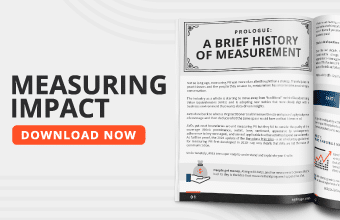As PR professionals are aware, your PR strategy must include tracking campaign performance and measuring the results. Keeping a close eye on how your PR campaigns perform is paramount to understanding your brand, your audience, and the overall market. However, the process itself is not always straightforward.
This guide will be revealing why tracking PR metrics is so vital, as well as five top metrics to track, and how you should measure them to gain proper insights and inform future decisions.
The importance of tracking PR campaigns
There are lots of different reasons why you want to track and measure the performance of your PR campaigns. Whether you are running a campaign to promote a solution like Platform.sh, a new e-commerce store, a physical product, or anything else, here is why you should keep a close eye on its performance.
You can improve future campaigns
Perhaps the top benefit you can reap from regularly measuring your PR campaigns is the ability to craft much better and more targeted campaigns in the future. By knowing how a campaign is performing and why,you will be able to leverage the same best practices to boost your chances of future success.
For example, if you were launching a campaign explaining to your audience what is supply chain optimization and what its benefits are, you could analyze the results of that campaign to discover how many people were interested in the topic, which channel performed better, what device people used to view the campaign, and so on.
Knowing that this was a hot topic among your audience and that most of your customers viewed the campaign could help you craft future campaigns following similar directions.

You can showcase your success to colleagues and clients
Another important reason to monitor your campaigns is that it helps you to demonstrate your expertise and productivity to your superiors and clients. When measuring the performance of a campaign, in fact, you will need to track specific KPIs, which can uncover impressive data and figures.
To this effect, it can help to leverage data lakes (click here to help define data lake) as they will enable you to store huge amounts of data ready for later use.
You can, then, present those figures to the rest of your team (which helps to get them on board for future campaigns) and your clients (which allows you to prove your skills running a successful PR campaign backed by hard facts).
You can strengthen crisis management
Regularly assessing how your campaigns are performing can also be beneficial as a crisis communication and management tool. In the PR world, few things are as overwhelming and potentially disastrous as a media crisis, so you should take any preventative measures to avoid it.
Monitoring your PR campaign is one of them. If you keep a close eye on any bad coverage or other issues that might hamper your brand’s reputation, you will be in a much better place to take proactive action if a crisis arises.
Five key metrics to track and the best ways to measure them
Now that you know why it’s so crucial to track your PR campaigns, you are ready to take a step further and put this knowledge into action. Let’s discover the most important PR metrics to monitor:

1. Number of publications
Let’s start with an easy metric: the number of publications that mention your brand, products, or services. Publications can include both online and printed media, depending on your specific strategy.
The analysis of publications can go from important websites that focus on industry-specific topics to others that use a cheap domain registration, since they might also help you reveal how your campaign is performing on a more local level.
How to measure it
To measure this metric, you will need to count all the publications in which your company (and/or its offering) gets mentioned during a set timeframe. While this is a relatively easy process, it can also be quite lengthy, which is why many companies turn to media agencies or automation tools for help.
2. Share of voice
Also known as “share of coverage”, the share of voice (SOV) metric refers to the percentage of media coverage that your brand, its high-level execs, and its offering hold in relation to its competitors.
Before measuring this metric, you will need to decide which and how many competitors to include in the calculation, so be sure to pick those who are genuinely direct rivals to your company.
How to measure it
To work out this figure, you need two pieces of information:
- The total number of online mentions of your brand during a specific timeframe
- The total number of online mentions of your competitors during the same time
Once you have this figured out, you can use the SOV formula and divide the total number of your brand’s mentions by the total number of your competitors. The number you end up with represents your share of voice for that given time.

3. Sentiment
Knowing how your brand and offering are talked about is a crucial factor in determining if your brand reputation is solid or if it might be at risk, whether you run your PR campaigns via print, social media, or post-purchase emails. Sentiment analysis can help you to find this out.
Through this process, you will no longer exclusively look at the quantity of your brand’s mentions, but will delve deeper into their quality. Are the mentions mostly positive? Negative? Neutral?
How to measure it
Until a few years ago, most companies would track sentiment across brand mentions in a manual way—not only an incredibly inefficient and time-consuming process, but also prone to errors.
Now, several specialist software tools can be used to target specific media outlets, channels, articles, and more to establish the sentiment of a brand mention. This, then, gets analyzed in detail and fed back to a system that stores all the mentions and divides them into separate categories depending on their nature.
Naturally, a large occurrence of positive mentions indicates a solid, stable, and thriving brand reputation, whereas mostly negative ones can be the first red flags that precede a PR crisis. Keeping up with the nature of your brand’s mention, therefore, can prove invaluable.
4. Media outreach
Another interesting metric to find out if you are having a successful PR campaign is media outreach, which involves the number of pitches and press releases that you send, as well as how they perform.
Tracking this metric helps you measure the amount of coverage they generate and it can be instrumental in enabling you to build stronger relationships with journalists and media experts.
Additionally, tracking the performance of your press releases by utilizing track press release software can provide valuable insights into the reach and engagement of your press releases. This can be crucial for evaluating their effectiveness in reaching your target audience and generating media coverage.
By monitoring metrics such as the number of times a press release was viewed, shared, or picked up by media outlets, you can assess the impact of your press release distribution and refine your strategies for future campaigns.

How to measure it
Measuring this metric requires you to multiply the total number of press clippings collected in a specific timeframe by the circulation of each clipping. Let’s assume, for instance, that your campaign appeared in two big digital publications, like The New York Times and The Guardian.
To calculate, say, your monthly media outreach, you’d need to take the average number of website visits per month for both publications (around 70 million for the New York Times and 19 million for the Guardian) and combine them. Your estimated media outreach, therefore, would be 89 million.
While this often produces impressive figures, like the ones we mentioned above, it’s also important to note that not all media impressions are 100% guaranteed. A lot of it also depends on where in the publication your article appeared, as that will determine whether or not many people genuinely read it.
5. Online traffic
Website traffic is also a good indicator of success in your PR efforts. Visitor numbers will give you some idea of success, as any increase will show that brand awareness is high. On the flip side, a decrease could indicate an unsuccessful campaign or a downturn in your reputation.
However, this doesn’t tell the whole story. For example, it’s helpful to know which visitors are first-timers and which are returnees who’ve been persuaded to revisit your site. You need to drill down into the numbers and find out where your traffic originates from.
This will tell you which campaigns and channels are proving most effective, while demographics such as age group, location, and device will show whether you’re reaching your target audience.
How to measure it
Set yourself a benchmark by measuring web traffic before and after a campaign. You can then see changes in traffic by looking at new visitor numbers and visitor recency. Also, look for spikes in the number of qualified leads and conversions. If the PR campaign is working, you’ll see an increase.
There are plenty of tools to help you measure web traffic, such as Google Analytics, Semrush, and Ahrefs. Here are some metrics to consider:
- Earned traffic (visitors resulting from earned coverage and link placement)
- Referral traffic (visitors from external sources like blog posts or social media)
- Click-through rate (CTR) from emails or social media
- Goal conversions (subscribing, filling out a form, completing a transaction).
You’ll have a lot of data to analyze, so you might want to consider using ETL data solutions. These tools enable you to extract data from a wide range of sources and turn it into actionable insights that can inform meaningful business decisions.

The takeaway
Running a bunch of successful PR campaigns is only half the battle: the really complex thing is knowing how these campaigns perform to learn and improve from them.
This is not always a straightforward or immediate process – it can often take time and effort – but is always worth it. So, are you going to follow these tips after you have launched your next PR campaign?







